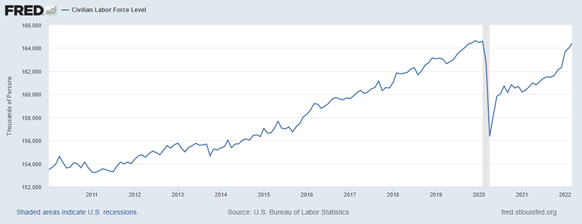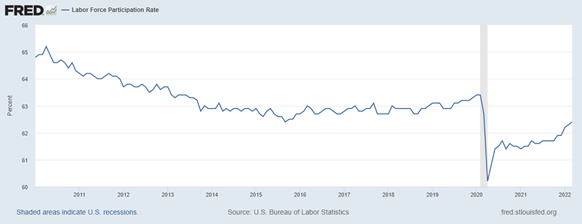This past Friday evening I was on a flight from Fairbanks to Anchorage and many of the seats around me were occupied by members of an Alaska trade group. Their conversation moved between all the topics that one might expect after a couple of day of meetings: their happiness with the success of the trip, the fact that they would get to sleep in their own beds, and connections they had made. My ears, which are incapable of not hearing conversations around me, also heard them talking about their concern that their industry wouldn’t be able to find enough workers particularly with the number of federal infrastructure dollars set to flow into the state.
Those concerns echo across the state and across sectors: transportation, trade, tourism, construction, healthcare, professional business services, etc. The list goes on of sectors that are looking for workers and not finding them. This issue isn’t limited to Alaska; it’s a national challenge and one that’s unlikely to fully resolve any time in the near future. The national economy is growing rapidly, there are many unfilled jobs, and there just aren’t enough workers. It’s a simple supply and demand: 11 million open jobs and 6 million unemployed workers.
In January I was invited to speak on this issue by another Alaska industry association and here’s what I shared with them:
Civilian Labor Force
Simply put, the civilian labor force is smaller than used to be and the growth trend has changed. The civilian labor force peaked in late 2019 at 164.6 million people. When COVID hit in March 2020, 10 million Americans exited the labor force. It’s taken more than two years for the labor force to come back to 164.4 million people. However, being at 164.4 million versus 164.6 million doesn’t bring us back to where we should be. You’ll notice in the figure below that the labor force was growing between 2014 and 2019. On average we were adding more than 1.5 million workers a year to our national labor force. All things being equal, we should have 168+ million people in the labor force. Now in the last six months two million Americans, incentivized by rising wages and the effects of inflation, have come back, but were still “off trend” by nearly four million workers.
Labor Force Participation Rate
It’s not just the size of the labor force (the number of potential workers) that’s broken trend, we’re also facing labor force participation rate challenges. The labor force participation rate is an estimate of the active work force. You’re a participant in the labor force if you have a job or are actively looking for a job. The difference between the participation rate and the labor force is that the labor force includes people who are not working because of vacation, being ill, being laid off. If you’re simply not looking to work than you’re not part of the labor force or the participation rate. Our participation rate had been steady since 2014/2015, plummeted during the early stages of the pandemic, and is still 1.5 percentage points below the pre-pandemic rate. In short, we have people who consider themselves in the labor force, but they’re not really participating in it. These people are sitting on the sidelines, but they’re dressed for the game.
What Gives? (And what doesn’t)
Between the people not being in the labor force and being in the labor force, but not really participating the country is “missing” around 6-7 million workers. The situation has improved slightly in recent months, but we’re a long way from having a normal labor market. I want to try to succinctly explain what’s causing the labor market disruption (the realities) and what’s not a major contributing factor (the myths).
Myth- Young People Aren’t Working
While it is true that youth labor force participation is lower than it was twenty years ago, the current youth labor force participation rate is in line with pre-pandemic levels. In fact, youth aged 20-24 are 15-20 percent more likely to be participating in the labor force than the general populace. They have a participation rate of 72 percent comparted to just over 62 percent for the general populace.
Myth- Unemployment Aid is Keeping People from Taking a Job
Supplemental unemployment insurance aid ended for all states last September, but half the states ended supplemental aid programs in June 2021. States which ended aid early saw no significant increase in employment rates compared to states that ran the program through September and additional econometric research found that aid programs only shifted the chances of an unemployed person from finding a taking a job from 25 percent per month to 22 percent per month. In summary, with aid, the average time it took a person to find and take a job went from 3 months to 3.3 months (a difference of just over a week).
Reality- Boomers are Exiting the Labor Market
In 2020 and 2021 the number of baby boomers who entered retirement hit 3.2 million and 3.3. million respectively compared to 1.5 million in 2019 and 2.2. million in 2018. That’s three million more workers heading to retirement who might otherwise have stayed in the labor force a couple more years. TD Ameritrade estimates that 40 percent of the missing labor force are people aged 55 or older who might otherwise be working. Traditionally many of these people have retired and reentered the labor market in other jobs. As they’ve said in pop culture, “Elvis has left the building.”
Reality- Childcare Issues Forced Women Out
In January 2021, the number of mothers with school age children who had a job was 18.5 million compared to 20.5 million in October 2019. The disruption to school schedules (initially) and the childcare market drove women out of the workforce in early 2020. While schools are back in session the childcare market has never come back largely because of labor shortages. There are 2 million trained moms out there right now who could be working if their families had access to the childcare market that existed in 2019.
Reality- Legal Immigration Has Taken a Dive
Between 2016 and 2022 (ongoing) legal immigration to the United States dropped precipitously. The U.S., like many countries, has long struggled with the tension between the fact that immigrants are an important source of population and economic growth and the nativist sentiment that immigrants take employment opportunities from citizens. The reduction in legal immigration to the country means we’re likely “short” two million foreign-born workers who never came to the U.S.
If you take boomer retirements, the number of women missing from the work force, and the reduction in legal immigration you’re getting to the point of explaining 80-85 percent of our labor force issues. If you throw on the fact that more then 500,000 Americans started their own businesses during the pandemic and another 250,000 working-age citizens died from the pandemic itself you’re now explaining 90-95 percent of the missing labor force.
Jonathan’s Takeaway: Most things in life defy simple explanations. The current state of the labor market is no different with retirements, childcare issues, lack of immigration, new sole proprietorship creation, and the pandemic itself combining to create a messy labor market. Next month I’ll focus on what we can do to get more Americans into the labor force.
Jonathan King is a consulting economist and Certified Professional Coach. His firm, Halcyon Consulting, is dedicated to helping clients reach their goals through accountability, integrity, and personal growth. Jonathan has 24 years of social science consulting experience, including 18 years in Alaska. The comments in this blog do not necessarily represent the view of employers and clients past or present and are Jonathan’s alone. Suggested blog topics, constructive feedback, and comments are desired at askjonathan@apcm.net.
4/18/22









